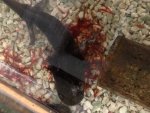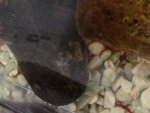Hello everyone! This is my first time posting. At my work, in my part of the building we have 3 axolotls as pets that we all look after together. There are lots of other's in another part of the building that are taken care of by another coworker (our axolotl expert you might call him). We have asked him to consult with us on the condition of one of our axolotls, but he could only venture a guess.
Here goes: our darker (wild type?) male axolotl has always been skinnier than the two girls in the tank, but in the last year he has been getting skinnier and skinnier (you can see his pelvic bones sticking out !).
He seemed healthy in all other ways so we thought (as he is old, not quite sure exactly how old) it might just be his time. BUT recently his skin has started turning white in patches. At first there was a spot on his head, that was small and it grew larger, but then stayed stable for a few weeks and our expert though it didn't look like an infection, just maybe a change in pigmentation (he had heard of darker axolotls going white when they are older, like vitiligo). The patch remained unchanged for weeks and weeks, but almost over night it spread more on his face and now all four limbs have the same thing happening to varying degrees.
He was also recently bitten bad on the leg by on of the girls and seems to be holding his leg quite still so we seperated him to his own tank yesterday (we only had a plastic container, and then today we put him in his own 5 gallon tank with substrate and atube to hid in and a small pump to keep the water from stagnating...he ate normally yesterday, his gills are a bit curled forward, but his tail straighten out after we moved him (he was a bit upsate as you can imagine)...he seems okay in his new home behaviour wise...maybe a bit still/quiet, usually he swims and gulps air a lot more than the girls.
We are keeping him away from the other's until he heals...anyone seen this discolouration before? Is it an infection that needs to be treated by fridging or salt baths? Or should we just let him relax in his retirement home, and keep him seperate forever??
Here goes: our darker (wild type?) male axolotl has always been skinnier than the two girls in the tank, but in the last year he has been getting skinnier and skinnier (you can see his pelvic bones sticking out !).
He seemed healthy in all other ways so we thought (as he is old, not quite sure exactly how old) it might just be his time. BUT recently his skin has started turning white in patches. At first there was a spot on his head, that was small and it grew larger, but then stayed stable for a few weeks and our expert though it didn't look like an infection, just maybe a change in pigmentation (he had heard of darker axolotls going white when they are older, like vitiligo). The patch remained unchanged for weeks and weeks, but almost over night it spread more on his face and now all four limbs have the same thing happening to varying degrees.
He was also recently bitten bad on the leg by on of the girls and seems to be holding his leg quite still so we seperated him to his own tank yesterday (we only had a plastic container, and then today we put him in his own 5 gallon tank with substrate and atube to hid in and a small pump to keep the water from stagnating...he ate normally yesterday, his gills are a bit curled forward, but his tail straighten out after we moved him (he was a bit upsate as you can imagine)...he seems okay in his new home behaviour wise...maybe a bit still/quiet, usually he swims and gulps air a lot more than the girls.
We are keeping him away from the other's until he heals...anyone seen this discolouration before? Is it an infection that needs to be treated by fridging or salt baths? Or should we just let him relax in his retirement home, and keep him seperate forever??



